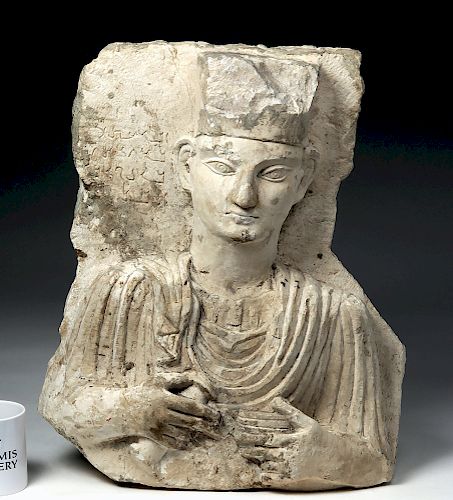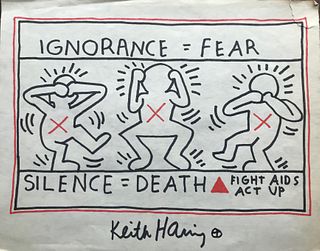Large / Rare Palmyran Limestone Bust w/ Inscription
Lot 94a
About Seller
Artemis Fine Arts
686 S Taylor Ave, Ste 106
Louisville, CO 80027
United States
Selling antiquities, ancient and ethnographic art online since 1993, Artemis Gallery specializes in Classical Antiquities (Egyptian, Greek, Roman, Near Eastern), Asian, Pre-Columbian, African / Tribal / Oceanographic art. Our extensive inventory includes pottery, stone, metal, wood, glass and textil...Read more
Categories
Estimate:
$18,000 - $25,000
Absentee vs Live bid
Two ways to bid:
- Leave a max absentee bid and the platform will bid on your behalf up to your maximum bid during the live auction.
- Bid live during the auction and your bids will be submitted real-time to the auctioneer.
Bid Increments
| Price | Bid Increment |
|---|---|
| $0 | $25 |
| $300 | $50 |
| $1,000 | $100 |
| $2,000 | $250 |
| $5,000 | $500 |
| $10,000 | $1,000 |
| $20,000 | $2,500 |
| $50,000 | $5,000 |
| $100,000 | $10,000 |
| $200,000 | $20,000 |
About Auction
By Artemis Fine Arts
May 10, 2018
Set Reminder
2018-05-10 10:00:00
2018-05-10 10:00:00
America/New_York
Bidsquare
Bidsquare : Fine Ethnographic / Asian / Ancient Art
https://www.bidsquare.com/auctions/artemis-gallery/fine-ethnographic-asian-ancient-art-3213
Featuring antiquities from around the world including Pre-Columbian, Tribal, Classical, Asian, so much more! Artemis Fine Arts info@artemisfinearts.com
Featuring antiquities from around the world including Pre-Columbian, Tribal, Classical, Asian, so much more! Artemis Fine Arts info@artemisfinearts.com
- Lot Description
Near East/Holy Land, Palmyra, Roman period, ca. 2nd to 3rd century CE. A high relief funerary bust, hand-carved from limestone, depicting half of the body of a man. His face is smooth, his eyes large and staring straight ahead, the pupils and irises incised to give him a more lifelike appearance. He wears a tall, conical modius, with a chlamys secured at one shoulder; the thick folds and drapes of the fabric have been well-carved by the creator. In one hand, he holds a bowl or goblet; in the other he holds a scroll-like object or possibly a tall, thin vessel with a wide, spool-shaped mouth. To the right of his head are three lines of inscribed Aramaic, partially visible. The other side of his head may once had had more writing or a carved architectural feature like a column, based on similar examples. Size: 6.4" L x 17.25" W x 20.75" H (16.3 cm x 43.8 cm x 52.7 cm)
Palmyra was a wealthy city that linked the caravan routes from the Parthian Near East with the Roman Mediterranean; the people who lived there during this period largely enjoyed prosperity and were able to adopt eastern and western customs, clothing, and artistic styles, creating a distinctive visual culture unique to the city. We know of this culture today from the large funerary monuments that the Palmyrans built - tower-shaped vaults whose interiors were lined with sculpted limestone reliefs depicting the deceased. Many of these, as this example, had Aramaic inscriptions which gave the name and family history of the dead.
This bust is very similar - including the items in the hand and the clothing - to this example at the British Museum: http://www.britishmuseum.org/research/collection_online/collection_object_details.aspx?objectId=282719&partId=1&images=true
Provenance: private Davis collection, Houston, Texas, USA; ex-Gerhard Hirsch Nachfolger Auction 277-278, Munich, Germany, lot 557
All items legal to buy/sell under U.S. Statute covering cultural patrimony Code 2600, CHAPTER 14, and are guaranteed to be as described or your money back.
A Certificate of Authenticity will accompany all winning bids.
We ship worldwide and handle all shipping in-house for your convenience.
#132781Loss to top of modius as shown. Loss to some of the fingers, and to one lower corner and one side of the uncarved plaque (which may have had Aramaic on it or some other carving). Nose is fully restored as is part of one hand. Surface deposits, with scratches and chips commensurate with age.Condition
- Shipping Info
-
All shipping is handled in-house for your convenience. Your invoice from Artemis Gallery will include shipping calculation instructions. If in doubt, please inquire BEFORE bidding for estimated shipping costs for individual items.
-
- Buyer's Premium



 EUR
EUR CAD
CAD AUD
AUD GBP
GBP MXN
MXN HKD
HKD CNY
CNY MYR
MYR SEK
SEK SGD
SGD CHF
CHF THB
THB


















